Romania: 2016 Article IV Consultation-Concluding Statement of the IMF Mission
Context: hard won gains at risk
1. Romania has made important progress in addressing economic imbalances and restoring growth. Fiscal and current account deficits have improved markedly since the global financial crisis, per capita income has surpassed pre-crisis levels, and growth is projected to be amongst the highest in the region in the near term.
2. However, macroeconomic policies have weakened recently and hard won gains are at risk of being reversed. The 2016 budget inappropriately gives stimulus when consumption growth is already strong. If no measures are taken, next year’s fiscal deficit will exceed the authorities’ target and there is a risk that further deficit-increasing measures may be passed in an election year that would put debt on an upward trajectory. Legislative initiatives in the financial sector, such as the current version of the giving-in-payment law (datio in solutum), contain provisions that could threaten private property rights, undermine investor sentiment, and curtail credit provision to households and businesses; there are better ways to target relief to distressed borrowers. The mission recommends stronger efforts to maintain prudent policies and resume the structural reform momentum in order to safeguard hard won gains.
Outlook: cyclical upswing
3. The economy is on a cyclical upswing supported by strong domestic demand. Private consumption has been boosted by recent hikes in minimum and public wages, record low interest rates, low fuel prices, and a VAT reduction on food items. Investment has recently shown some signs of a pick-up, partly related to a catch-up in EU funds absorption. On the basis of the largely one-off stimulus to consumption, the mission expects real GDP growth of 4.2 percent in 2016, decelerating to 3.6 percent in 2017. Notwithstanding this cyclical performance, raising Romania’s potential output growth will hinge on strong progress on structural reforms.
4. Risks to the outlook relate mostly to the pre-electoral environment and external uncertainties. Further fiscal stimulus in an election year may boost consumption in the short-term but will undermine sustainability of public finances and could dent market sentiment. Measures targeting the financial sector lacking proper impact analysis and consultation could harm credit intermediation and investment and undermine financial stability. On the external side, an abrupt deterioration in emerging market risk perception could trigger currency depreciation and raise the external debt ratio.
Fiscal policy: boost resilience to shocks
5. Fiscal policy is pro-cyclical and will put public debt on a gradually rising trajectory. Romania achieved impressive fiscal consolidation since 2009—one of the largest amongst peers. However, the large fiscal relaxation approved last year is expected to reverse this trend and deviate from the previously announced fiscal path. Although the fiscal code contains welcome simplification of the tax code, the fiscal stimulus is difficult to justify at a time when economic growth is already strong. In light of this expansion, the fiscal deficit is projected to exceed the authorities’ target by ? percent of GDP in 2017 unless further measures are taken (table). Even if the deficit is kept at the authorities’ target of 2.8 percent of GDP (in cash terms, equivalent to about 3 percent in ESA terms), public debt will exceed 40 percent of GDP and continue to gradually rise. Although the current level of debt-to-GDP is not high relative to conventional metrics, public debt tripled between 2008 and 2015, showing the vulnerability to a sudden deterioration in public finances.
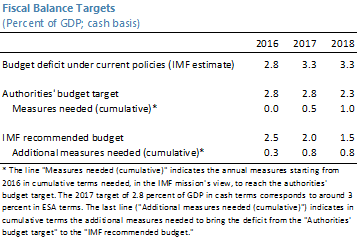
6. The mission recommends anchoring fiscal policy on a debt-reduction path. Gradual fiscal adjustment to reach a deficit of 1.5 percent of GDP (cash basis) in 2018 will achieve this goal and protect against downside risks (chart). The effort should start this year with spending discipline and better tax administration to find and preserve savings to keep the deficit at 2.5 percent of GDP. For 2017, the mission recommends a deficit of 2 percent of GDP. Postponing the further tax reductions on VAT and excises scheduled to come into effect next year would generate savings of ? percent of GDP. These could be used for both achieving the recommended deficit target and addressing other needs such as in the health and education sectors or for the gradual implementation of the unified wage law.
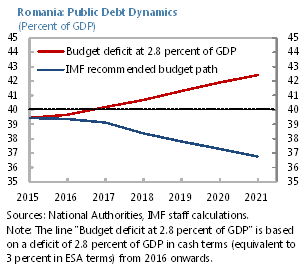
7. More broadly, the authorities should strengthen the credibility of fiscal institutions. The current budget waived the provisions of the Fiscal Responsibility Law and the fiscal rule embedded in domestic legislation. It is important to integrate better the work of the Fiscal Council into Parliament’s decision-making, which will strengthen the credibility of the budget process.
8. Efforts to bolster effectiveness, efficiency, and transparency in public administration are crucial. The tax administration agency should become more business friendly, focus more on high revenue potential taxpayers by strengthening its risk-based audit system, and enhance efforts to reduce tax evasion and avoidance. Progress in prioritization of large public investment projects is welcome. The mission recommends extending this to other projects and making greater use of EU-funded projects. The mission welcomes plans to carry out a spending review. It should start with a few pilot sectors to identify room for efficiency gains. Targeting of social protection schemes should be strengthened. New legislation on natural resource taxation should be approved to give certainty on the tax framework. The public procurement law should be passed and progress on centralizing procurement to generate savings should continue. Recent efforts to enhance transparency of spending of public entities are welcome and should help to improve accountability and efficiency of public spending. The mission also welcomes current efforts to reform public administration.
Monetary policy: shifting gears
9. Against the backdrop of declining inflation, policy rate cuts provided unprecedented and appropriate stimulus in recent years. In a welcome move, the National Bank of Romania (NBR) has narrowed the interest rate corridor and further reduced minimum reserve requirements on both leu- and FX-denominated liabilities. However, there has been a persistent gap between the interbank market rate and the policy rate. The exchange rate is currently broadly in line with medium-term fundamentals and reserve coverage is adequate.
10. While headline inflation is currently negative, underlying inflation, adjusting for recent tax changes, has been rising. On the back of strong domestic demand, a closed output gap, the large fiscal impulse, and significant wage growth, headline inflation is expected to rise to close to 3? percent—the upper end of the NBR’s target band—by end-2017.
11. The mission recommends leaving the policy rate unchanged for now but to begin to reduce the gap between the policy and interbank market rates. Given the current negative headline inflation, the low imported inflation ahead, and the uncertainty around inflation expectations, the policy rate can be left unchanged until projected inflation moves more clearly above target. Nonetheless, the NBR should consider signaling a tightening bias and begin to reduce the gap between the market and policy rates by absorbing liquidity from the market and narrowing the interest rate corridor. Given the large pro-cyclical fiscal impulse, monetary policy may need to shoulder some of the burden for managing domestic demand.
Banking sector: preserve hard-won achievements
12. The recent reduction in NPLs was a hard won achievement and legislative initiatives that could undermine financial stability should be avoided. This refers, in particular, to the current version of the giving-in-payment law, which involves retroactive application and may affect government guarantees granted under the Prima Casa mortgage scheme. The mission is similarly concerned about the forced conversion of foreign-currency denominated loans being considered in parliament that would also entail a retroactive change in contracts. The mission encourages the authorities to also revisit some elements of existing legislation on abusive clauses in order to dispel another important source of uncertainty, while securing fairness for all stakeholders. Finally, the mission recommends putting in place the prerequisites for implementing the recently adopted personal insolvency law.
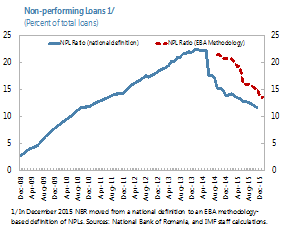
Structural reforms: realize unmet growth potential
13. The mission commends the progress made in the fight against corruption and encourages continued vigor to address remaining challenges. Improving governance and the fight against corruption are not only key socio-economic issues, they are also critical from a macro-economic perspective. Lower corruption will help curtail tax evasion (chart) and reduce waste in spending taxpayer money. It will also promote a better business environment and attract foreign investment.
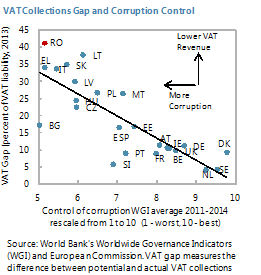
14. Improved governance of energy and transport sector state-owned enterprises (SOEs) as well as larger involvement of private capital in those sectors remain key reform priorities. The mission recommends the adoption and steadfast implementation of the draft legislation on improving corporate governance for SOEs. The mission also advises to aggressively restructure the SOEs in dire financial situation and adopt a focused list of potential IPOs and privatizations. These reforms would help improve the professionalism of SOEs’ management and resource allocation, raise profitability, reduce government transfers, and limit the scope for contingent liabilities for the state.
15. Excessive minimum wage rises should be avoided. Minimum wage policy can provide protection to low income workers. However, with the sharp hike planned for this year, the ratio of minimum-to-average wage in Romania will surpass the regional average (chart). This may undermine external competitiveness and hamper job creation, particularly for low-skilled labor and in labor-intensive industries. The pace of future minimum wage increases should be moderate and balance social considerations with competitiveness, productivity growth, and employment prospects.
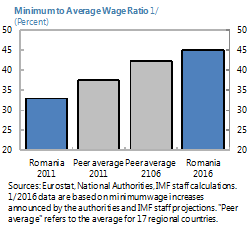
The mission is grateful to the authorities and other counterparts for their warm hospitality and excellent cooperation.




Комментарии